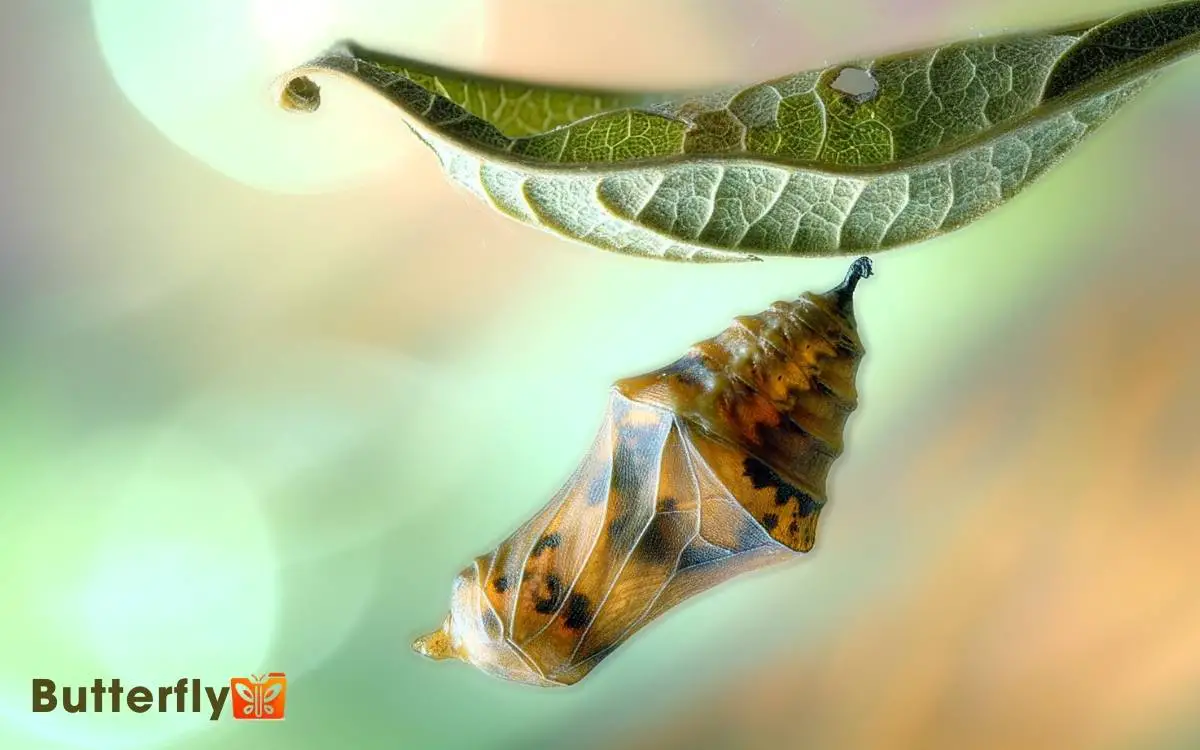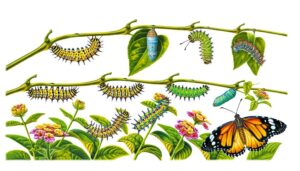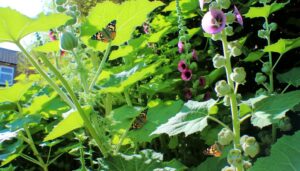Dead Painted Lady Butterfly Chrysalis: Understanding Signs!
A dead Painted Lady butterfly chrysalis often shows distinct signs like darkening, black spots, or shriveling. Healthy chrysalises are vibrant green or golden, but if they turn black, brown, or develop red and pink discolorations, it may indicate infections.
Recognizing these symptoms and understanding their causes are essential to ensuring better survival rates for future chrysalides by taking appropriate preventative measures. Discover more about maintaining ideal conditions and handling techniques.

Key Takeaways
Metamorphosis of Painted Lady
The metamorphosis of the Painted Lady butterfly, Vanessa cardui, involves four distinct stages: egg, larva, pupa, and adult. Each stage exhibits remarkable physiological and morphological changes.
The egg, often laid on host plants like thistles, hatches into a larva (caterpillar) within about 3-5 days. The larva feeds voraciously, growing rapidly through five instars. After roughly 10-12 days, the larva forms a pupa or chrysalis, attaching itself to a substrate with silk.
Inside the chrysalis, intense cellular reorganization occurs, transforming the larva into an adult butterfly. This pupal stage lasts around 7-10 days.
Emergence as an adult marks the final stage, where the butterfly’s primary focus shifts to reproduction and dispersal, continuing the cycle of metamorphosis.
Identifying a Dead Chrysalis
To identify a dead Painted Lady chrysalis, one should note any significant color changes such as darkening or black spots that indicate decay.
Observers should also examine the physical condition, checking for shriveled or dried-out appearances that suggest desiccation. These signs are critical for determining the viability of the chrysalis.
Color Changes Observed
Observing the color changes in a Painted Lady butterfly chrysalis offers crucial clues for identifying whether it’s dead.
A healthy chrysalis typically exhibits vibrant green hues or occasionally golden tones. Over time, it may shift to a darker shade as metamorphosis progresses.
However, a dead chrysalis often turns black or dark brown prematurely, indicating halted development. Additionally, red or pink discolorations can suggest bacterial or fungal infections, leading to the organism’s demise. These abnormal color shifts are critical warning signs.
When examining a chrysalis, noting these specific changes allows for accurate determination of its status. Consistent monitoring and understanding these variations help in proper identification, thereby aiding in effective management of butterfly populations or educational displays.
Physical Condition Signs
Noting color changes serves as a fundamental step, but physical condition signs provide more definitive evidence when identifying a dead Painted Lady butterfly chrysalis.
A healthy chrysalis maintains a firm texture; however, a dead one often appears shrunken or desiccated. Gently touching the chrysalis can reveal if it’s overly soft or unusually hard, both indicators of death.
Additionally, the presence of mold or a foul odor signifies decomposition. The chrysalis may also exhibit structural damage, such as cracks or ruptures, which compromise its integrity.
Observing these physical condition signs, in combination with color changes, offers a robust method for determining the chrysalis’s viability. This approach ensures accurate conclusions about the Painted Lady butterfly’s developmental status.
Common Causes of Mortality
Furthermore, the mortality of Painted Lady butterfly chrysalises can be attributed to parasitism by wasps or other insects. These parasites lay their eggs inside the chrysalis, and the emerging larvae consume the developing butterfly from within.
Additionally, fungal infections present another significant threat. Fungi such as Beauveria bassiana infiltrate the chrysalis, leading to tissue degradation and eventual death.
Bacterial infections also play a role; pathogenic bacteria can enter through small punctures or abrasions, causing septicemia.
Furthermore, improper handling or disturbances during the pupal stage can result in mechanical damage, impeding proper development.
Predation by birds and small mammals shouldn’t be overlooked, as they often find chrysalises to be an easy and nutritious target.
Impact of Environmental Factors
Environmental factors play an important role in the survival and development of Painted Lady butterfly chrysalises. Temperature, humidity, and light exposure have a substantial impact on their viability.
Ideal temperature ranges between 20°C and 25°C are necessary for proper metamorphosis; deviations can disrupt development or cause mortality.
Humidity levels around 70% prevent desiccation of the chrysalis, while excessive moisture can lead to fungal infections. Light exposure regulates circadian rhythms important for synchronized emergence.
Additionally, pollutants like pesticides and heavy metals can compromise their physiological processes, leading to deformities or death.
Abiotic stressors such as strong winds or sudden temperature drops can physically damage the chrysalises. Therefore, understanding and mitigating these environmental factors is crucial for the conservation of Painted Lady butterflies.
Predators and Parasites
Predators and parasites, often overlooked in studies, pose a considerable threat to the survival of Painted Lady butterfly chrysalises. Various predators, including birds and small mammals, can easily target these vulnerable stages.
Parasitic wasps and flies lay their eggs inside the chrysalises, leading to the larvae consuming the developing butterfly from within. These threats greatly reduce the chances of successful metamorphosis.
Consider the following impacts:
- Predatory birds: Swiftly snatch chrysalises, depriving them of a chance to transform.
- Mammalian foragers: Destroy chrysalises while seeking food.
- Parasitic wasps: Inject eggs, causing internal destruction.
- Parasitic flies: Infest chrysalises, leading to fatal outcomes.
- Ants: Invade and consume the chrysalises, preventing butterfly emergence.
Understanding these threats highlights the delicate balance in Painted Lady butterfly survival.
Disease and Infection
Disease and infection often manifest in Painted Lady butterfly chrysalises through discoloration, unusual odors, and abnormal fluid excretion. Recognizing these indicators early can prevent the spread of pathogens to other larvae and pupae.
Implementing strict hygiene practices and maintaining ideal environmental conditions are essential for infection prevention.
Common Disease Indicators
Identifying common disease indicators in a Painted Lady butterfly chrysalis involves examining symptoms such as discoloration, abnormal texture, and the presence of fungal or bacterial growth.
Discoloration typically presents as dark spots or overall dullness, whereas abnormal texture might include a brittle or squishy feel.
Fungal or bacterial growth often appears as fuzzy, mold-like patches or slimy areas. Observing these signs early can help determine the health status of the chrysalis.
Recognizing these indicators can evoke concern, prompting more attentive care for other chrysalides.
- Dark, uncharacteristic spots on the chrysalis
- Brittle or overly soft texture
- Fuzzy, mold-like patches indicating fungal growth
- Slimy or wet areas suggesting bacterial infection
- A lack of normal, vibrant coloration
Infection Prevention Tips
To prevent infections in Painted Lady butterfly chrysalides, maintaining a clean and controlled environment is vital.
First, sanitize all containers and tools with a mild bleach solution before use. Guarantee proper ventilation to discourage mold growth. Regularly remove any frass (butterfly waste) and debris, which can harbor pathogens.
Monitor humidity levels, keeping them within the ideal range of 60-70%, as excessive moisture can promote fungal infections. Pre-screen host plants for pests and diseases to avoid introducing harmful microorganisms.
If a chrysalis appears diseased, isolate it immediately to prevent cross-contamination. Routine observation for any signs of infection, such as discoloration or unusual odors, is crucial for early intervention.
These practices greatly reduce infection risks in Painted Lady chrysalides.
Nutritional Deficiencies
Nutritional deficiencies in the Painted Lady butterfly chrysalis can lead to stunted growth and compromised development. These deficiencies often result from inadequate food sources during the larval stage, impacting the chrysalis’s ability to metamorphose effectively.
Observations have documented the following consequences:
- Malformed wings
- Delayed emergence
- Weakened exoskeleton
- Reduced lifespan
- Increased mortality
The chrysalis’s diet must include essential nutrients like proteins, lipids, and carbohydrates to support proper development. Lack of these nutrients disrupts physiological processes, leading to physical deformities and heightened vulnerability to diseases.
A balanced diet during the larval stage is essential for the chrysalis’s transformation into a healthy adult.
Understanding these nutritional needs helps in preventing the tragic outcomes associated with deficiencies, safeguarding the Painted Lady’s successful lifecycle continuation.
Handling and Care Tips
Proper handling and care of the Painted Lady butterfly chrysalis are crucial to guarantee successful metamorphosis and emergence.
When transferring the chrysalis, one should use tweezers to avoid direct contact, as oils from the skin can penetrate the protective casing.
Make certain the chrysalis is suspended in a well-ventilated environment, maintaining a stable temperature around 72-78°F. Humidity levels should be monitored, kept between 60-70%, to prevent desiccation.
Position the chrysalis so it hangs freely, ensuring no obstructions to wing expansion. During this stage, minimize disturbances to reduce stress.
Observing these meticulous steps aids in preserving the delicate balance required for the chrysalis to transform into a healthy Painted Lady butterfly, avoiding developmental complications. Ensuring a stable environment with consistent humidity and temperature further supports the successful emergence of the butterfly. Any disruptions during this stage could lead to deformities or an unsuccessful transformation of the painted lady butterfly chrysalis. Careful monitoring and minimal interference help guarantee a smooth transition from chrysalis to butterfly.
Enhancing Survival Rates
Guaranteeing ideal conditions during handling and care lays the foundation for enhancing survival rates, requiring meticulous attention to environmental factors and developmental stages.
Painted Lady butterfly chrysalises demand specific humidity levels, temperature ranges, and minimal disturbances to thrive. Caregivers must monitor these variables closely, adjusting as necessary.
- Humidity: Maintaining perfect moisture levels prevents desiccation.
- Temperature: Stable temperatures ensure proper metabolic rates.
- Air Circulation: Adequate ventilation reduces mold and bacterial growth.
- Light: Controlled light exposure aligns with natural circadian rhythms.
- Rest Periods: Minimizing handling reduces stress and developmental disruptions.
These practices foster a nurturing environment, ensuring the Painted Lady butterfly’s progression from chrysalis to vibrant adulthood is both successful and inspiring. Understanding these needs is crucial for improving survival rates.
Conclusion
To sum up, understanding the factors affecting the mortality of painted lady butterfly chrysalises can greatly enhance their survival rates.
For example, a study observed that chrysalises kept at a stable temperature and humidity had a 30% higher survival rate compared to those exposed to fluctuating conditions.
By recognizing signs of disease, predation, and environmental stressors, and providing ideal care, enthusiasts can improve the chances of successful metamorphosis and contribute to the species’ conservation.






